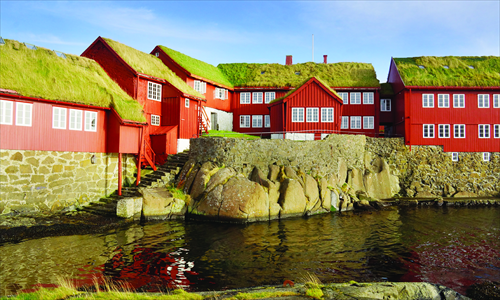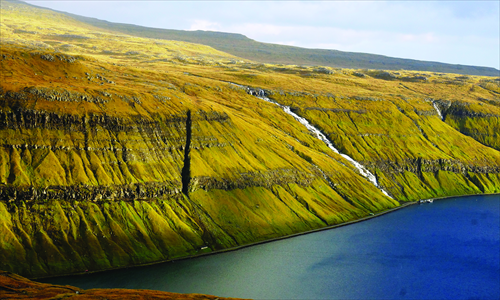HOME >> LIFE
Discover the undiscovered
By Sindy Chan Source:Global Times Published: 2016/1/15 9:41:38

Faroese grass-roofed wooden houses Photo: Sindy Chan

A view of the shore in the Faroe Islands Photo: Sindy Chan
After my trip to the Faroe Islands I tried my hand at a bit of poetry:Once upon the time the Faroes was found/ The mighty Atlantic Ocean splashed Faroese green, Faroese blue, Faroese red onto the land/ The first settlers came/ the archipelago named/ The Islands of the Sheep.
Still not sure where is the Faroe Islands? There's a local legend that can provide a further clue.
The giant and the witch
A view from the village of Tjornuvik on Faroe's largest island Streymoy reveals two stone formations standing in the surging waves of the North Atlantic. Legend says the giants of Iceland were envious of the people of Faroe and decided to take the Faroe Islands for themselves. A giant and a witch (Risin and Kellingin) were sent to the islands with orders to bring all the islands back to Iceland. They struggled to travel across the ocean for an entire night but could not arrive before dawn and so were turned into stone by the first shaft of sunlight coming over the horizon. For this reason, the Faroe Islands did not become part of Iceland but remained a self-governing country with its own heritage and culture within the Danish Realm.
Inspired by Faroese shipping company Smyril Line's slogan "Visit the past today," my friends and I were convinced that an authentic Faroese experience would not be complete without a ferry rise across the North Atlantic. We took the long way around: First taking a six-hour DSB train from Copenhagen to Hjoerring to connect to a local train that took us to Hirtshals, where we boarded the MS Norröna for a two-day ferry ride to Torshavn.
We were greeted by a spectacular scene as we pulled into the Torshavn harbor - A shore dotted with house lights that lit up the pre-dawn sky, sleepy little fishing boats, hewn-stone houses of grass roofs, white smoke pouring from chimneys...
Dinner and a show
Our dinner at the KOKS Restaurant at the Foroyar Hotel was exceptional. The finely prepared meal consisting of nine glasses of wine, eight appetizers, 12 courses and one dessert walked us through the seasons, colors and spirit of the Faroe Islands with its simple, pure and traditional culinary art.
The horse mussel and lemon verbena thyme soup turned out to be refreshingly tasty. We also feasted on queen scallop and sea urchin which had only been caught a few hours earlier. The main course - Fulmar and Beetroot, a unique Faroese dish made from a local seabird and beetroot - was absolutely delicious.
All seafood and fish served at KOKS were wild and authentically Faroese.
After dinner we decided to continue exploring the culture the islands possess.
We went to a concert featuring singer Dánjal á Neystabø at the Reinsaríið, Torshavn's cultural performance venue. A group of four played the cello, drums and guitar while Neystabø sang and played the piano. We joined in singing with some locals as they echoed Neystabø singing an original song.
"Raindrops in the sea working under cover/ protecting you and me from each other," an amazing traditional Faroese song about life, love and nature modernized by Neystabø. It was a spiritually splendid evening.
On the shore
Traveling around the Faroes is best done by car. We were not able to rent a car but luckily we had Per Hansen spending a day with us.
Born and raised in Torshavn, Per is an entrepreneur and official guide working for the Faroe Islands Tourism Board.
In Faroes, rainbows and waterfalls usually follow the rain. Per told us that the Gasadalur waterfall is breeding ground for Faroese Fulmar, the seabird we had eaten for dinner the night before.
At 6 months old, young Fulmars learn to take off from the plateau where the waterfall is located. However, some of the better-fed ones tend to be too fat and heavy to fly, and end up falling into the ocean instead of taking off. Locals in boats collect the birds from the water and take them home to eat.
Per thoughtfully arranged a lunch at the guesthouse Gjáargarður in the "Green" village of Gjógv on the island of Eysturoy.
Beautiful as a water-color painting, the little village of Gjógv, with its less than 50 inhabitants, is one of Faroe's best preserved and most-visited villages.
Per told us that in a land of less than 50,000 people and 70,000 sheep, we definitely had to get some "sheep experience." He brought us to a friend's house in Tjornuvik, where the family was busy making a kind of salami-like sausage.
"The family just slaughtered a sheep. They try to make use of everything. It's lots of hard work," Per said.
Per showed us a typical "drying house" in one village. The traditional means of drying, fermenting, salting and smoking fish and meat for the winter is still in practice today.
On our way back to Torshavn, Per made a quick stop in front of a headless sheep lying on the road. Per explained that black sheep are difficult to see at night and that this one must have been fatally hit by a car. In order to quickly relieve its pain, the driver who hit the sheep cut its head off. It was an act of mercy not cruelty.
"Bang! Bang!" we heard some gunshots in the distance.
"Hare hunters. Hunting season just began," Per told us.
Hare hunting in the Faroe Islands is a popular hobby. Anyone can be a hunting enthusiast, a manager, farmer or any other profession.
Per followed the sound of the shooting to find two cars parked by a tunnel entrance. Three hare hunters with shotguns and bandoliers were skinning their prey on the ground. We took a photo of a content hunter who proudly held his hare to close our amazing day.
On our own
Over the next several days we traveled on our own. A 20-minute car ferry brought us to the island of Nolsoy where we took several bus trips around, including to the second largest city Klaksvik on the island of Bordoy.
Like a guardian angel, the Presbyterian Church by the beautiful Klaksvik Valley subtly reminds passersby of the British invasion of the Faroe Islands in April of 1940. Faroes Vágar Airport, built by the British Royal Engineers in 1942-43 is another memorial to Britain's presence in the Faroes.
The infrastructure in the Faroe Islands is very good. The public buses in Torshavn are free. For the rest of the islands, every small village is connected by either road or ferry. Passengers who need to change buses between two points have to call and request their bus connections. The bus will then wait at the connection point until the passenger comes. This is the Islands - ancient and modern, rural and urban.
There is a lot of good food and wine to be had in the Faroes. Barbara Fish House in a hidden alley of Torshavn has the best deep-fried fish and Faroese potato pil pil (potatoes sautéed in fish oil).
We ate at the Áarstova Restaurant not only for its famous lamb dishes but also for its history. The little house by the brook is where famous Faroese poet brothers Janus and Hans Andrias Djurhuus were born and grew up. The Áarstovu Brothers were the grandsons of Jens Christian Djurhuus (1773-1853), the first poet to write poems in the Faroese language.
The Etika, a Japanese sushi restaurant, provides great value for your money. The sashimi platter consists of extremely generous portions of fresh Faroese seafood at a very inexpensive price.
Thursdays are when the Norrona sails back from Iceland to Torshavn and back to Hirtshals.
I began going over my fondest Faroese memories as we took the same ferry back to Denmark.
We lingered in Denmark, staying two days in Herlev, a charming little town in Copenhagen where the bustling city center is just a 20-minute train ride away. The hospitable Getty and Leslie, the owners of the Herlev Kro, reminded me of the straight-forward and passionate islanders of the Faroes.
I had a hard time connecting to the hotel Internet with my dying laptop (my state-of-the-art portable computer had somehow disappeared in the hustle and bustle of the metropolis), the front office manager immediately called her IT colleague to come and assist - it was 8 o'clock Sunday morning.
The Faroe Islands are National Geographic's No. 1 "Readers' Choice" 2015 among 111 island communities for being a sustainable, culturally minded, authentic, superlative and timely destination for travelers.
For me, the Faroe Islands are a pristine land and all-season travel destination. It's a place you definitely will not regret visiting for a few days.
Posted in: Feature